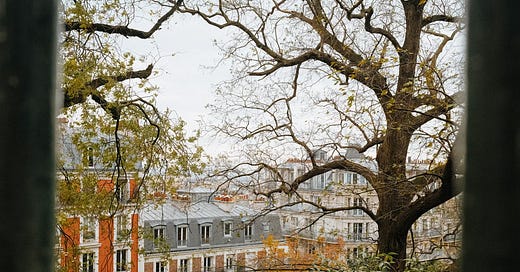An Invitation to Belong: Social Trajectories and Artistic Purpose in 'A Moveable Feast'
Finding our purpose as artists through the memoir of Ernest Hemingway.
Hemingway’s memoir explores not just the art which Paris inspires in many artists, but also the nuanced tension between arriving as an outsider hoping to belong, and being invited and welcomed into the city’s already thriving artistic community. This dichotomy reveals a deeper commentary on creative legitimacy and the forces that shape our artistic identity to this day.
Back in the 1920s, the desire to move to Paris mirrored the longing I find in myself even today, ever since my first visit to the city in 2019. Paris in the 20s wasn’t just a city; it was a beacon for art, intellect, and freedom from the darkness of the First World War. Authors, poets, painters, political thinkers, and the laissez-faire dreamers of Harvard and Yale flocked to the French capital during what became known later as “Les Années Folles”—The Crazy Years. Imagine strolling the streets and bumping into Gertrud Stein, F. Scott Fitzgerald, James Joyce, Henri Matisse, Jean Arp, Max Ernst, Marie Laurencin, Salvador Dalí, Pablo Picasso, Josephine Baker, Man Ray, or Ernest Hemingway. It was the heavy-hitter heyday of culture, where every corner seemed to promise rubbing shoulders with greatness.
In A Moveable Feast, Hemingway’s vivid recollections (how valid the memories truly are, remain to be confirmed) capture the beauty and tension of those formative years. Days were spent writing in spartan apartments or quiet cafés, while evenings dissolved into smoke-filled debates over wine, eau de vie, and grappa. At the time, Hemingway was a journalist for the Toronto Star. He immersed himself in Paris’ artistic pulse, honing his craft in the company of others who, like him, sought to transform their struggles into something lasting. But alongside the creativity lay privilege: Hemingway arrived only with his wife while many others arrived already connected to cultural elites or supported by family or personal means. You see, Paris first slowly, then all at once, became both a stage for those seeking inspiration and a destination for those who had already been invited into its circles.
This dichotomy—arriving as a seeker and belonging through invitation—is at the heart of Hemingway’s reflections, though I don’t remember him explicitly mentioning it. In his memoir, the tension between these two paths emerges more as a sub-commentary on the nature of creativity and the structures of artistic recognition. Whether one arrives nameless or celebrated, A Moveable Feast suggests that Paris demands something more: the willingness to endure its trials and allow its unique magic to transform the artist.
Arrival as Aspiration
Hemingway’s portrayal of his initial arrival in Paris in A Moveable Feast is filled with chapter after chapter of a narrative ambition and a yearning to define himself as an artist. He describes Paris as a city of infinite possibility, where “all of the lights were brighter”. Streets seemed to hum with creative energy. For Hemingway, Paris was not merely a physical destination but a symbolic one—a crucible for artistic renewal and self-invention. His decision to move showed his trust and belief in a place; a sentiment echoed by countless expats, who sought refuge in its enclaves.
However, Hemingway’s early days in Paris were marked by struggle. It wasn’t pretty, though it’s a form of romanticism I find bearable. His memoir; underscoring the challenges of arriving as an outsider, recounts living in a minimal apartment with his wife, Hadley, rationing money for food and the heat needed to cook it. Even today, financial insecurity can heighten imposter syndrome in so many of us, and as Hemingway began navigating the world of literary giants like Gertrude Stein and James Joyce, their reputations dwarfed his ambitions. The yearning for artistic recognition in Hemingway’s reflections through narrative prose is palpable; we effortlessly see ourselves in him.
Paris’ allure as a creative haven lies in its duality: it is both invitation and indifference. As I’ve only ever visited, for Hemingway, he was certain the city offered inspiration with no guarantees, forcing him to grapple with his craft in solitude before earning acknowledgment.
Let’s pause to think about this in relation to our own art. Do you believe this isolation can become a positive crucible for our work, or do we craft in solace for nothing? Is our art our self-made RSVP into these social circles we dream of residing in? Is that the goal? Is it why we create in the first place?
To Hemingway, art begins not with the invitation to a community but with the personal act of committing oneself to creation, despite one’s external hardships. His Paris was a city that stripped away comfort to reveal artistic intent, where ambition fuelled the first steps toward mastery, not belonging.
This dynamic—between the promise of Paris and the reality of its demands—reflects our first universal truth about the creative process: it often begins in struggle and isolation, requiring the artist to endure before they belong.
As I begin prepping a Part II on this topic, I want to leave you with a statement for this Sunday afternoon’s pondering: We find the belonging we believe earned.
For those intrigued by Ernest Hemingway’s book, consider grabbing a copy of A Moveable Feast.
If Marie Laurencin’s art interests you, the next time you’re in Paris, visit the Bibliothèque Kandinsky, which holds significant archives of Laurencin’s works. For my fellow Torontonians, take yourself out on a date to the Toronto Reference Library and see what you can discover about her, Hemingway, and “The Crazy Years” of Paris.






